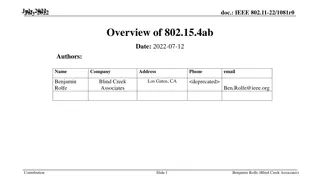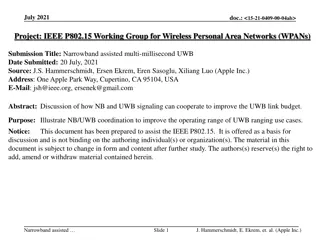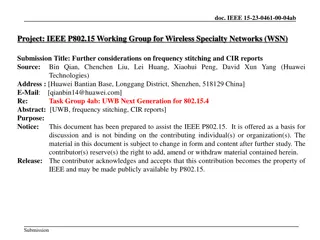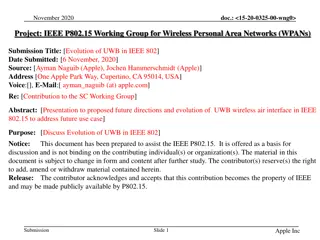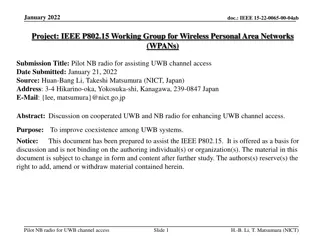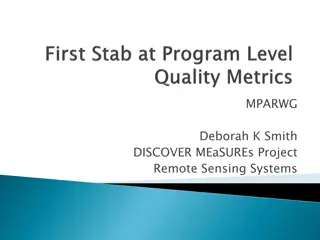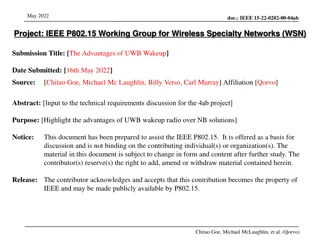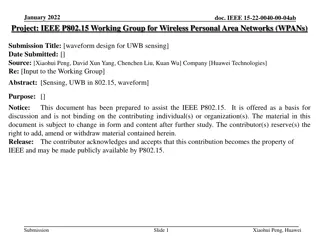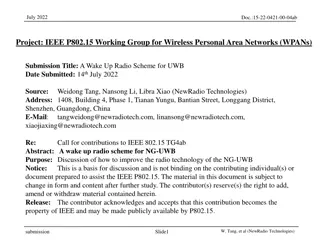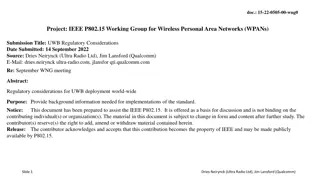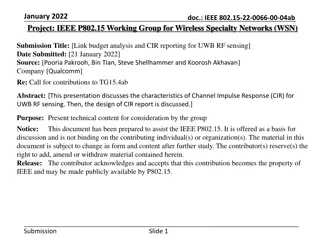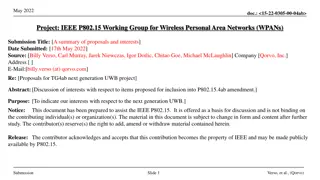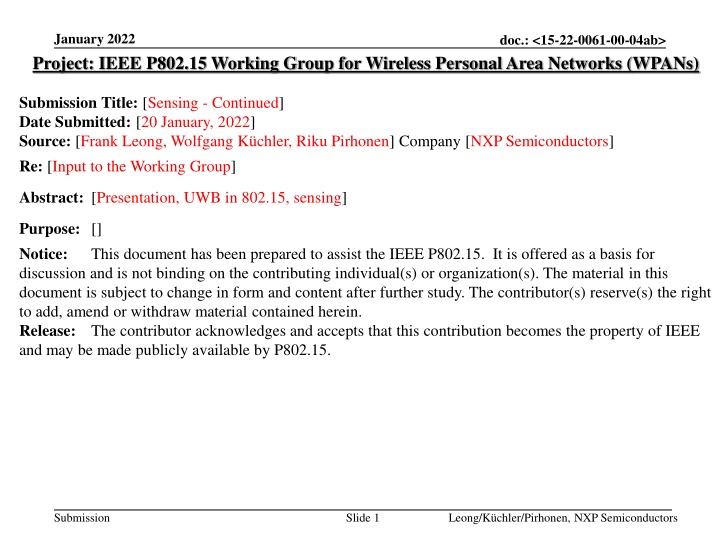
Sensing in IEEE P802.15 Working Group: UWB Technology Advancements
This document presents advancements in Ultra-Wideband (UWB) technology within the IEEE P802.15 Working Group, focusing on sensing capabilities for presence detection and environment mapping. It discusses strategies for improved accuracy, reduced power consumption, and enhanced interoperability in wireless personal area networks.
Download Presentation

Please find below an Image/Link to download the presentation.
The content on the website is provided AS IS for your information and personal use only. It may not be sold, licensed, or shared on other websites without obtaining consent from the author. If you encounter any issues during the download, it is possible that the publisher has removed the file from their server.
You are allowed to download the files provided on this website for personal or commercial use, subject to the condition that they are used lawfully. All files are the property of their respective owners.
The content on the website is provided AS IS for your information and personal use only. It may not be sold, licensed, or shared on other websites without obtaining consent from the author.
E N D
Presentation Transcript
January 2022 Project: IEEE P802.15 Working Group for Wireless Personal Area Networks (WPANs) doc.: <15-22-0061-00-04ab> Submission Title: [Sensing - Continued] Date Submitted: [20 January, 2022] Source: [Frank Leong, Wolfgang K chler, Riku Pirhonen] Company [NXP Semiconductors] Re: [Input to the Working Group] Abstract: [Presentation, UWB in 802.15, sensing] Purpose: [] Notice: discussion and is not binding on the contributing individual(s) or organization(s). The material in this document is subject to change in form and content after further study. The contributor(s) reserve(s) the right to add, amend or withdraw material contained herein. Release: The contributor acknowledges and accepts that this contribution becomes the property of IEEE and may be made publicly available by P802.15. This document has been prepared to assist the IEEE P802.15. It is offered as a basis for Submission Slide 1 Leong/K chler/Pirhonen, NXP Semiconductors
January 2022 doc.: <15-22-0061-00-04ab> PAR Objective Safeguards so that the high throughput data use cases will not cause significant disruption to low duty-cycle ranging use cases Interference mitigation techniques to support higher density and higher traffic use cases Other coexistence improvement Backward compatibility with enhanced ranging capable devices (ERDEVs) Improved link budget and/or reduced air-time Additional channels and operating frequencies Proposed Solution (how addressed) Re-use of existing PHY elements Carrier frequency plan in line with Sensing requirements Improvements to accuracy / precision / reliability and interoperability for high-integrity ranging Reduced complexity and power consumption Hybrid operation with narrowband signaling to assist UWB Enhanced native discovery and connection setup mechanisms Sensing capabilities to support presence detection and environment mapping Low-power low-latency streaming Higher data-rate streaming allowing at least 50 Mbit/s of throughput Support for peer-to-peer, peer-to-multi-peer, and station-to- infrastructure protocols Infrastructure synchronization mechanisms Outlining key Sensing PHY and MAC aspects Submission Slide 2 Leong/K chler/Pirhonen, NXP Semiconductors
January 2022 doc.: <15-22-0061-00-04ab> Sensing - Continued Submission Slide 3 Leong/K chler/Pirhonen, NXP Semiconductors
January 2022 doc.: <15-22-0061-00-04ab> 802.15.4ab Context Recap Focus on key functionalities to be provided by UWB: 1.Ranging with high integrity (handsfree access use cases) 2.Localization (indoor navigation use cases) 3.Sensing (presence detection use cases) 4.Coordination & scheduling to support the above Provide accurate ranging via a low-cost, mass-market solution a. Low energy-per-ranging b. Low channel-occupancy-per-ranging a.k.a. spectral efficiency (many devices operating at the same time & place) c. Re-use of hardware between use cases Submission Slide 4 Leong/K chler/Pirhonen, NXP Semiconductors
January 2022 doc.: <15-22-0061-00-04ab> UWB Sensing Terminology Recap CIR = Channel Impulse Response (estimated characteristics) Stations/Modules Monostatic Operation (Nstations = 1) Multistatic Operation (Nstations = 2...16) Sensing Initiator/Responder One-Way/Two-Way Multistatic Sensing CIR Transmitter/Receiver Parallel/Sequential Multi-Antenna Operation Virtual Antennas (e.g., electronic beamsteering*) *) E.g., see: U. Nickel: Fundamentals of Signal Processing for Phased Array Radar , in Advanced Radar Systems, Signal and Data Processing (pp. 1-1 1-22), 2007. Submission Slide 5 Leong/K chler/Pirhonen, NXP Semiconductors
January 2022 doc.: <15-22-0061-00-04ab> UWB Sensing More Terminology Illuminating Signal (from Sensing Transmitter/Initiator) Echo Signal (to Sensing Receiver/Responder): Sensing Processor creates Sensing Result from Sensing Measurement Submission Slide 6 Leong/K chler/Pirhonen, NXP Semiconductors
January 2022 doc.: <15-22-0061-00-04ab> Use of Multiple Antennas per Station Specify existing ternary (Ipatov) sequences to be used for sensing as drop-in replacement for STS segments (i.e., support multiple Ipatov segments separated by gaps) This could support per-segment assignment of (virtual) TX antennas Consider explicit signaling to indicate intention to use a packet for sensing (e.g., setting a PHR bit) Submission Slide 7 Leong/K chler/Pirhonen, NXP Semiconductors
January 2022 doc.: <15-22-0061-00-04ab> UWB Sensing Pulse Shape Avoid both pre-ringing and post-ringing Approximate a Gaussian pulse shape to be used for Sensing For Sensing, specify a smooth Kaiser window (time-bounded) with L equivalent to 3 chips and = = 10 as reference shape Submission Slide 8 Leong/K chler/Pirhonen, NXP Semiconductors
January 2022 doc.: <15-22-0061-00-04ab> UWB Sensing Carrier Grid Spacing Performing sensing at multiple carrier frequencies allows to achieve large effective total bandwidth In order to avoid artifacts, some overlap may be desirable Overlap somewhere between 25-75% may be desirable Carrier grid spacing of 124.8 MHz allows to choose between 124.8 MHz (N+1, i.e., ~75% overlap), 249.6 MHz (N+2, i.e., ~50% overlap), and 374.4 MHz (N+3, i.e., ~25% overlap) configurations Submission Slide 9 Leong/K chler/Pirhonen, NXP Semiconductors
January 2022 doc.: <15-22-0061-00-04ab> UWB Sensing CIR Sharing (I) Dedicated Information Element for CIR sharing Facilitate centralized processing (i.e., support the use of dumb edge nodes) Support transmission of selected ranges of CIR taps (referred to 0 meters) Support complex CIR tap sizes of 2*{8,12,16,24} bits CIR tap I&Q amplitudes encoded in linear scale, with sampling rate ({1,2,4,8} times the chip rate), reference level and tap size (I&Q always of same size) to be set via dedicated IE or OOB means Structure / Order of Transmission: Main Header Range Header 1 Range Body 1 Range Header 2 Range Body 2 ... Range Header N Range Body N Submission Slide 10 Leong/K chler/Pirhonen, NXP Semiconductors
January 2022 doc.: <15-22-0061-00-04ab> UWB Sensing CIR Sharing (II) Main Header (transmitted 1x) Field Name Field Length (Bits) Description Compression 1 Set when using DEFLATE (i.e., Zip) compression of fields beyond the first octet Reserved 7 Reserved Number of Ranges 8 Number of CIR ranges transmitted Submission Slide 11 Leong/K chler/Pirhonen, NXP Semiconductors
January 2022 doc.: <15-22-0061-00-04ab> UWB Sensing CIR Sharing (III) Range Header (transmitted for each range) Field Name Field Length (Bits) Description Local Antenna Number 5 Antenna associated with current CIR range Timeslot Number 3 Transmitted (Ipatov) segment associated with current CIR range, i.e., (virtual) TX antenna; all 1s means the current CIR range is associated with the preamble Line-Of-Sight Available 2 Signals whether (slow-moving/stationary) LOS path has been searched for (MSB) and whether it has been found (LSB) Reserved 3 Reserved Target Mode 1 Enabled if current CIR range contains target distance-velocity pairs instead of CIR tap amplitudes Range Start Index 16 Starting index (sample) of current range Length of Range (LoR) 10 Number of taps/elements in current range Submission Slide 12 Leong/K chler/Pirhonen, NXP Semiconductors
January 2022 doc.: <15-22-0061-00-04ab> UWB Sensing CIR Sharing (IV) Range Body (transmitted LoR times for each range, i.e., I&Q amplitude pairs for each tap or delay velocity pairs for each element) Field Name Field Length (Bits) Description In-Phase Amplitude {8,12,16,24} Amplitude scaled to pre-agreed level, encoded as signed integer (not transmitted in Target Mode) Quadrature Amplitude {8,12,16,24} Amplitude scaled to pre-agreed level, encoded as signed integer (not transmitted in Target Mode) Target Delay 12 Estimated distance of the current target, expressed in number of samples (only transmitted in Target Mode) Target Velocity 12 Estimated target velocity as signed integer multiple of 2.5e-3 m/s (only transmitted in Target Mode) Submission Slide 13 Leong/K chler/Pirhonen, NXP Semiconductors


